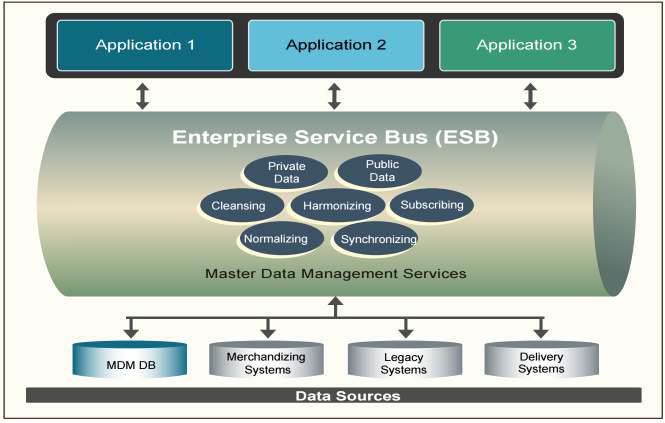RETAIL MASTER DATA MANAGEMENT
ORGANIZATION
The client is a leading privately-held grocery supermarket chain operating more than 300 stores in three states across the south-eastern United States. The retail grocery chain operation is spread over multiple categories including grocery, drugs, fresh produce, and baked goods.
The client wanted to implement a Master Data Management solution across multiple enterprise systems for standardizing, harmonizing, and stabilizing the global Master Data elements.
CHALLENGE
The client had previously implemented a large number of business systems, each needed to individually access the most recent and accurate version of the enterprise-wide master data. This resulted in different and often inaccurate values for the same copies of master data, which adversely impacted the efficiency of business processes, data reporting, and related analytics.
As a part of the Information Management Program, the client implemented a strategic initiative to address the management and chartering of four key master data elements: item, vendor, store, and warehouse. Inaccuracies included:
- Business users working with incorrect set of data attributes.
- Business users working with incomplete master data.
- Business users working simultaneously on different data values for the same Master Data entity.
- Individual departments using different systems to obtain information on the same item.
The lack of master data management ultimately resulted in additional costs and the potential for revenue loss remained high across the enterprise.
CURRENT TECHNICAL LANDSCAPE
Across the varied enterprise systems, the client lacked a centralized system of record for the creation, storage, usage, and maintenance of master data elements. Individual business units had the same type of master data stored in different systems (e.g., the Item Master for the business units was stored in three primary systems):
- Product merchandising management
- Legacy system
- Direct to store delivery system
Each individual system played the role of Gatekeeper for different attributes of a given master data element. Prior to XTIVIA’s solution, the state of master data management was as follows:
- 100+ applications containing Master Data
- 300+ Item attributes managed in nearly 30 applications
- 200+ Vendor attributes managed in nearly 14 applications
SOLUTION
XTIVIA employed a comprehensive Master Data Management (MDM) strategy for the client based on the approach of each organization employing a single source of accurate data. In lieu of implementing a single product-based MDM solution, the MDM strategy implemented and leveraged Enterprise Application Integration and Service Oriented Architecture (SOA).
The MDM solution further predicated a single data owner, a centralized application, and a unified data management process for each attribute of the given master data. The deployed solution was thus characterized by the following:
- Designating master systems for different attributes for a particular master data entity.
- Utilizing services for MDM.
- Synchronizing master data across individual business systems.
To realize the solution, the following types of services were designed and implemented:
PUBLIC SERVICES

Available for any application to invoke, they provided transparency to the consumer applications, from the data ownership systems and the underlying business logic. They provided users with the right set of data values for different department and different systems.
PRIVATE SERVICES
Built on the individual applications, provided the master data attributes for those attributes it effectively owned. These private data services provided the relevant attributes to the public service that invoke it. The end user applications had no direct access to the private services. These private services provided the decoupling from the public service, providing flexibility to change the underlying implementation.
SYNCHRONIZATION SERVICES
Synchronized the master data attributes once the data owner authorized the content for public consumption across all required enterprise systems.
RESULTS
The deployment and adoption of the MDM solution brought about numerous benefits:
- Providing a relevant, accurate, and complete set of data attributes in a timely manner thereby eliminating costly manual errors.
- Enabled analytical reporting on historical data (ranging from just days up to five years).
- Providing flexibility to change ownership for various data attributes for a given master data.
- Deploying reusable services that could be used by various applications, thus reducing future costs in implementing the same functionality.
- Adopting a set of standards for master data access in lieu of each application building a customized and costly data access mechanism.
KEY COMPONENTS
TECHNOLOGY USED
TIBCO™ – BusinessWorks; EMS; Hawk
TIBCO™ – Teradata Adapter; File Adapter
TIBCO™ SDK
TIBCO™ Administrator
Teradata®
Let's Talk Today!
XTIVIA CORPORATE OFFICE
304 South 8th Street, Suite 201
Colorado Springs, CO 80905 USA
Additional offices in New York, New Jersey,
Missouri, Texas, Virginia, and Hyderabad, India.
USA toll free: 888-685-3101, ext. 2
International: +1 719-685-3100, ext. 2
Fax: +1 719-685-3400
XTIVIA needs the contact information you provide to us to contact you about our products and services. You may unsubscribe from these communications at anytime, read our Privacy Policy here.
